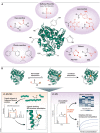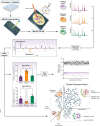Advances in high-throughput mass spectrometry in drug discovery
- PMID: 36515561
- PMCID: PMC9832828
- DOI: 10.15252/emmm.202114850
Advances in high-throughput mass spectrometry in drug discovery
Abstract
High-throughput (HT) screening drug discovery, during which thousands or millions of compounds are screened, remains the key methodology for identifying active chemical matter in early drug discovery pipelines. Recent technological developments in mass spectrometry (MS) and automation have revolutionized the application of MS for use in HT screens. These methods allow the targeting of unlabelled biomolecules in HT assays, thereby expanding the breadth of targets for which HT assays can be developed compared to traditional approaches. Moreover, these label-free MS assays are often cheaper, faster, and more physiologically relevant than competing assay technologies. In this review, we will describe current MS techniques used in drug discovery and explain their advantages and disadvantages. We will highlight the power of mass spectrometry in label-free in vitro assays, and its application for setting up multiplexed cellular phenotypic assays, providing an exciting new tool for screening compounds in cell lines, and even primary cells. Finally, we will give an outlook on how technological advances will increase the future use and the capabilities of mass spectrometry in drug discovery.
Keywords: MALDI-TOF; affinity selection; drug discovery; high-throughput screening; mass spectrometry.
© 2022 The Authors. Published under the terms of the CC BY 4.0 license.
Figures




References
-
- Adam GC, Meng J, Rizzo JM, Amoss A, Lusen JW, Patel A, Riley D, Hunt R, Zuck P, Johnson EN et al (2015) Use of high‐throughput mass spectrometry to reduce false positives in protease uHTS screens. J Biomol Screen 20: 212–222 - PubMed
-
- Akçay G, Belmonte MA, Aquila B, Chuaqui C, Hird AW, Lamb ML, Rawlins PB, Su N, Tentarelli S, Grimster NP et al (2016) Inhibition of Mcl‐1 through covalent modification of a noncatalytic lysine side chain. Nat Chem Biol 12: 931–936 - PubMed
-
- Annis DA, Athanasopoulos J, Curran PJ, Felsch JS, Kalghatgi K, Lee WH, Nash HM, Orminati J-PA, Rosner KE, Shipps GW et al (2004) An affinity selection–mass spectrometry method for the identification of small molecule ligands from self-encoded combinatorial libraries. Int J Mass Spectrom 238: 77–83
-
- Annis DA, Nickbarg E, Yang X, Ziebell MR, Whitehurst CE (2007) Affinity selection‐mass spectrometry screening techniques for small molecule drug discovery. Curr Opin Chem Biol 11: 518–526 - PubMed
Publication types
MeSH terms
LinkOut - more resources
Full Text Sources

